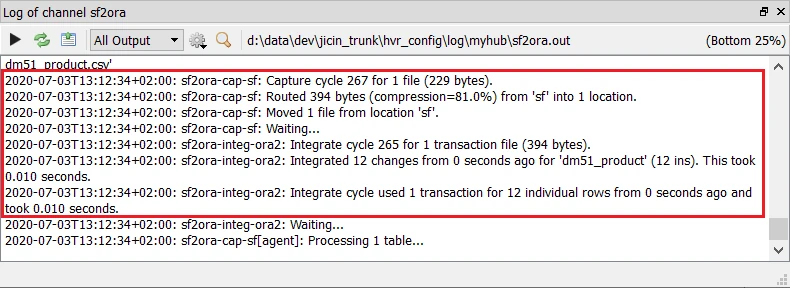Quick Start for HVR - Salesforce
This quick start guide helps you to get started with HVR for replicating data into Salesforce.
To proceed with this replication you must have a basic understanding about HVR's architecture and terminologies like Hub, Location, Channel, Location Groups, Actions etc.
The example here demonstrates how to replicate tables from one Oracle schema (source location) to a Salesforce location (target location) and also replicate changes from Salesforce location to Oracle schema. For this replication two HVR channels are required, one for replicating changes from Oracle to Salesforce (ora2sf) and the other one for replicating changes from Salesforce to Oracle (sf2ora). For simplicity, the Oracle schema will be located on the same machine as the hub database.
Before proceeding with this example ensure that the requirements for using HVR with Oracle and Salesforce are met.
For information about access privileges and advanced configuration changes required for performing replication using Oracle and Salesforce, see:
Create Demo Schemas, Tables and Objects
This section describes the procedure for creating Oracle schemas, tables, and Salesforce objects.
In the Oracle database, create two schemas (testdb1 and testdb2), one will be the source schema in the Oracle to Salesforce channel (ora2sf) and the other will be the target schema in the Salesforce to Oracle channel (sf2ora). Both of these schemas will contain one empty table (dm51_product). Skip this step if you already have schemas with tables that you plan to use for this replication.
Sample SQL statements to create schema and tables
Create Schema
create user testdb1 identified by hvr default tablespace users temporary tablespace temp quota unlimited on users;create user testdb2 identified by hvr default tablespace users temporary tablespace temp quota unlimited on users;Create Tables
create table testdb1.dm51_product ( prod_id number(10) not null, prod_price number(10,2) not null, prod_descrip varchar2(100) not null );create table testdb2.dm51_product ( prod_id number(10) not null, prod_price number(10,2) not null, prod_descrip varchar2(100) not null );Create Salesforce object HVR Demo Product that corresponds to the Oracle's dm51_product table. In Salesforce, database tables are called objects, columns are called fields, and rows are called records. Once the object is created, Salesforce assigns case-sensitive 'API names' for the object and its fields that must be matched to the corresponding 'base names' in the HVR channel (see section Define Actions below).
Log in to Salesforce and switch to Salesforce Classic.
In the top right menu bar, click Setup.
On the left side bar, navigate to Build and click Create ▶ Objects ▶ New Custom Object.
Enter the details for object HVR Demo Product as shown on the screenshot below.
For convenience, use the Oracle table name (dm51_product) for the Object Name.
The Record Name is the standard filed that will appear under the Standard Fields section once you create the object. The Record Name field is always called "Name" when referenced via the API. In HVR, it will be mapped to column prod_id in the Oracle table.
Ensure that the Allow Bulk API Access checkbox is selected.
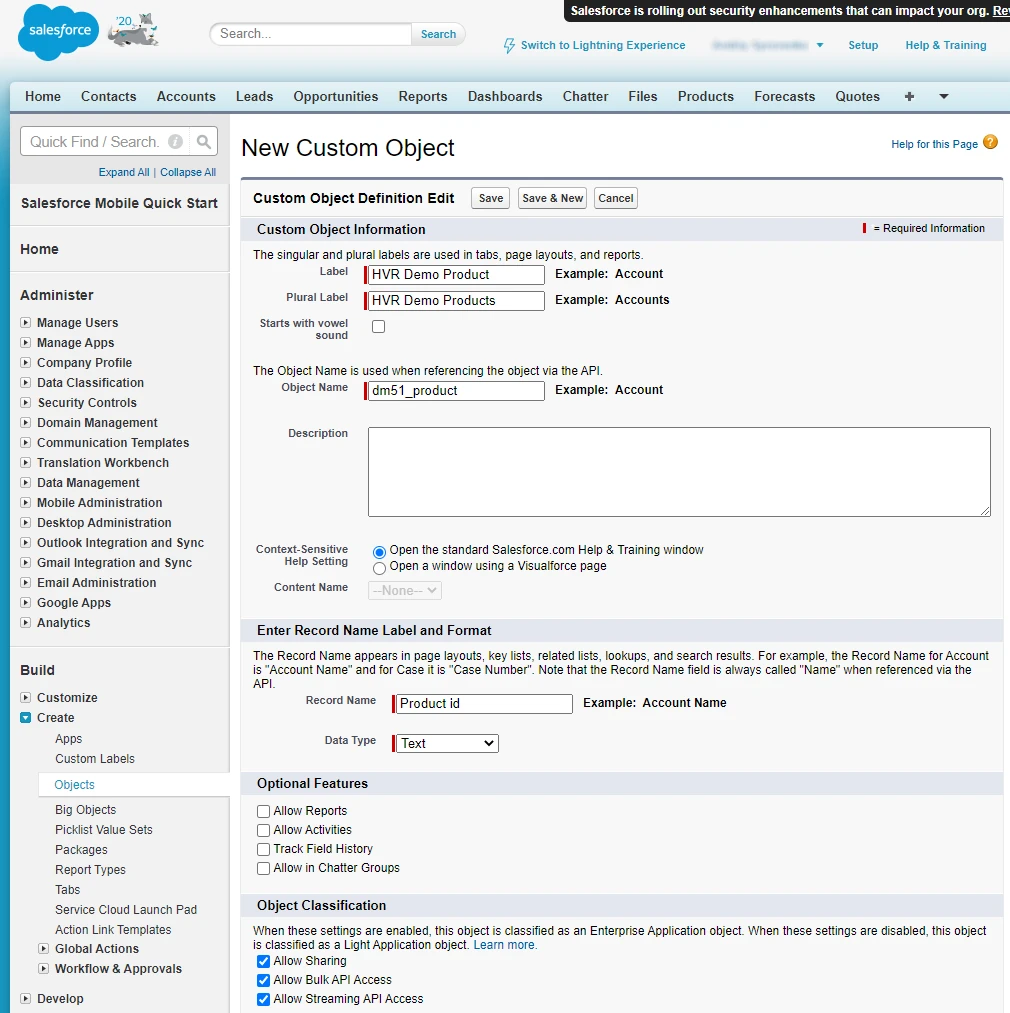
Click Save.
The HVR Demo Product details page will open. Note that the Standard Fields section will be auto-populated once you create the table object. Now, you need to create custom fields Price and Description that correspond to the relevant columns in the Oracle's source tables.
In the Custom Fields & Relationships section, click New.
In step 1, choose the field type. In this case, select Number. Click Next.
In step 2, enter details for the prod_price field as shown on the image below. Click Next.
- Enter 'Price' in Field Label. This is a label used on displays, page layout, reports, and list views.
- Enter '10' in Length and '2' in Decimal Places. These are the length of the Number and the number of decimal places.
- Enter 'prod_id' in Field Name. This is an internal reference and is used for integration purposes, such as API.

In step 3, establish filed-level security as needed.
In step 4, select the page layouts that should include this field and click Save & New.
Repeat the above steps to create new custom field Description.
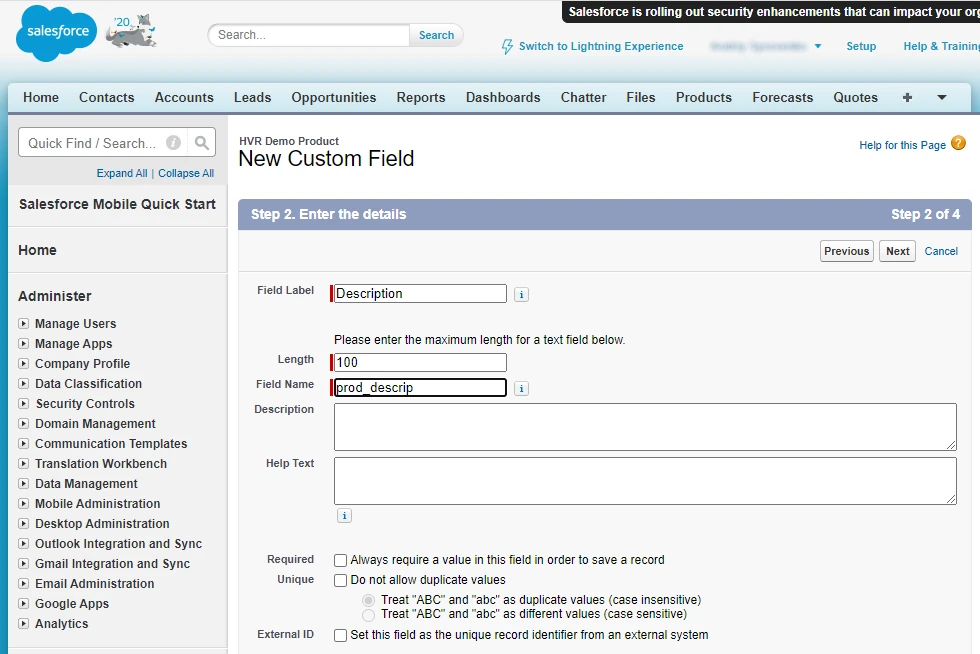
The following image shows the final configuration for object HVR Demo Product.
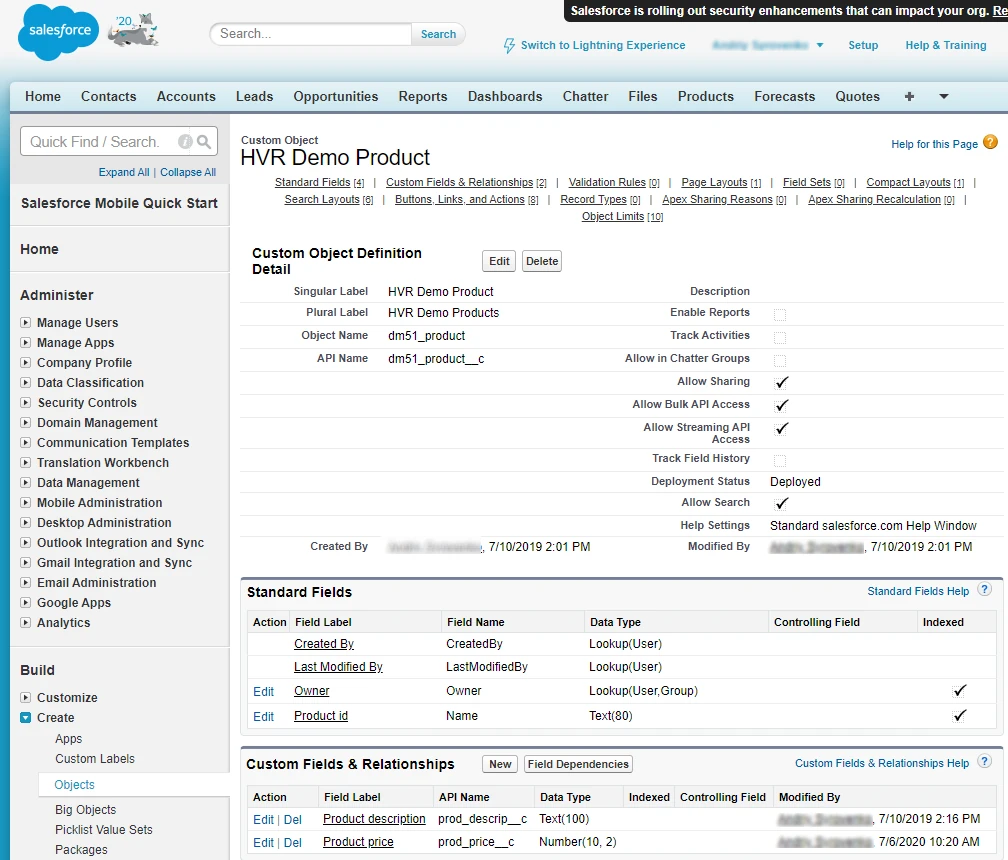
Create Hub Database
This section describes how to create a hub database (schema). The hub database is a repository database that HVR uses to control its replication activities. It contains HVR catalog tables that hold all specifications of replication such as the names of the replicated databases, the replication direction and the list of tables to be replicated. For more information about HVR hub server and database, see section Hub Server in System Requirements.
HVR supports the creation of a hub database on certain databases (location classes) only. For the list of supported location classes, see section Hub Database in Capabilities.
For this demonstration, the hub database (e.g. myhub) is created in Oracle.
Create the hub database (myhub) with password (hvr).
create user myhub identified by hvr default tablespace users temporary tablespace temp quota unlimited on users;
Grants/Access Privileges
This section describes the grants/access privileges required for the source schemas and hub database.
Configure the privileges for source schemas (testdb1 and testdb2). For more information, see section Grants for Log-Based Capture in Requirements for Oracle.
grant create session to testdb1; grant create table to testdb1; grant alter any table to testdb1; grant select any dictionary to testdb1; grant select any transaction to testdb1; grant create session to testdb2; grant create table to testdb2;Configure the privileges for the hub database (myhub). For more information, see section Grants for Hub Schema in Requirements for Oracle.
grant create session to myhub; grant create table to myhub; grant create procedure to myhub; grant create trigger to myhub; grant execute on dbms_alert to myhub;
Download and Install Salesforce Data Loader
- Log into www.salesforce.com.
- Click Setup ▶ Administrative Setup ▶ Data Management ▶ Data Loader.
- Download and install the ApexDataLoader.exe.
Download and Install HVR
An HVR distribution is available for download at the Fivetran.com website. For more information, see Downloading HVR.
Install HVR on a hub machine. For details on installing HVR, see the respective operating system sections:
The HVR distribution requires a license key in order for the software to operate. Please see the HVR licensing page for more details on how to install the HVR license.
After the installation, you can control HVR using the HVR graphical user interface (HVR GUI).
- If the hub machine is Windows, then HVR GUI can be executed directly on the hub machine.
- To control HVR remotely from your PC, connect to the hub machine using Windows Remote Desktop Connection and launch HVR GUI on the hub machine.
- If the hub machine is Linux, then HVR GUI can be executed directly on the hub machine. However, an application like X Server or VNC viewer must be installed to run HVR GUI directly on Linux.
- To control HVR remotely from your PC, install HVR on the PC (with Windows or macOS) and configure the HVR Remote Listener on the hub machine.
- If the hub machine is Unix, then HVR GUI should typically be run remotely from a PC to control HVR installed on the hub machine. To do this, install HVR on the PC (with Windows or macOS) and configure the HVR Remote Listener on the hub machine.
The HVR Remote Listener allows you to connect HVR GUI available on your PC to the remote HVR hub machine. For more information about connecting to remote HVR installation, see Configuring Remote Installation of HVR on Unix or Linux and Configuring Remote Installation of HVR on Windows.
Launch HVR GUI
This section describes how to launch HVR GUI on various operating systems.
On Windows and macOS, double-click the HVR shortcut icon available on the desktop or execute command hvrgui in the CLI.
On Linux, double-click the hvrgui file available in the HVR_extracted_path/bin directory or execute command hvrgui in the CLI.
Linux requires applications like X server or VNC viewer to execute HVR GUI.
On Unix, HVR GUI is not supported. So, HVR GUI should be run on a remote PC (with Windows, Linux, or macOS) to control HVR installed on the Unix machine.
Register Hub
This section describes how to connect HVR GUI to the hub database.
When you launch HVR GUI for the first time, the Register Hub dialog is displayed automatically. The Register Hub dialog can also be accessed from menu File ▶ Register Hub. Skip steps 1 to 4 if you want to run HVR GUI directly on the hub machine.
Click Connect to HVR on remote machine.
To connect HVR GUI on a PC to a remote HVR hub machine, the HVR Remote Listener must be configured and running on the HVR hub machine.
Enter the name or IP address of the hub machine in the Node field (e.g. myserver).
Enter the port number (defined in the HVR Remote Listener of the hub machine) in the Port field (e.g. 4343).
Enter the Login (e.g. myserveradmin) and Password for the hub machine. By default, this is the operating system login credentials of the hub machine.
Select Oracle in the Class pane.
Specify Database Connection details.
- Enter the directory path in ORACLE_HOME. You can also click the browse button to select the directory path.
- Enter the Oracle System ID in ORACLE_SID or TNS credentials.
- Enter the user name of the hub database in User (e.g. myhub).
- Enter the password for the hub database in Password (e.g. hvr).
Click Connect.

Click Yes in the prompt dialog asking to create catalog tables in the hub database.
HVR displays this prompt when connecting to a hub database for the first time.
On connecting successfully to the hub database, the navigation tree pane displays the hub machine and the hub database. Location Configuration, Channel Definitions, and Scheduler are displayed under the hub database.
Create Locations
This section describes how to create locations in HVR GUI. Location is a storage place (for example, database or file storage) from where HVR captures (source location) or integrates (target location) changes.
- Create two Oracle locations ora1 and ora2 (one for each channel).
- In the navigation tree pane, right-click Location Configuration ▶ New Location.
- Enter the Location name (ora1) and optionally the description for the location.
- Select Oracle in Class.
- Provide Database Connection details. For more information on Database Connection fields, see section Location Connection in Requirements for Oracle.
Enter the directory path for ORACLE_HOME. You can also click browse to select the directory path.
Enter Oracle System ID in ORACLE_SID, or TNS credential, or RAC credential.
For RAC connectivity, ensure to provide remote machine connection details under the Connection tab.
Enter a username of the source schema in User.
Enter a password for source schema in Password.
- Click Test Connection to verify the connection to location database.
- Click OK.

- Repeat steps 1-6 to create the second Oracle location (ora2).
Before creating the Salesforce location, set the $JAVA_HOME environment variable to the Java installation directory using action Environment.
- In the navigation tree pane, right-click channel ora2sf, click New Action ▶ Environment.
- In the Name field, type 'JAVA_HOME'.
- In the Value field, click the browse button and select the directory.
- Ensure to select all channels (*) so that this action is applied to both channels ora2sf and sf2ora.
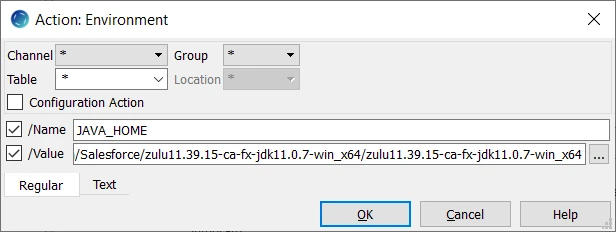
- Create Salesforce location sf.
- In the navigation tree pane, right-click Location Configuration ▶ New Location.
- Enter the Location name (sf) and optionally the description for the location.
- Select Salesforce in Class.
- Provide Database Connection details. For more information on Database Connection fields, see section Location Connection in Requirements for Salesforce.
Enter the URL for Endpoint.
Enter the Salesforce username in Login.
Enter the Salesforce password in Password.
Enter the directory path where the dataloader.jar file is located in Dataloader. The default installation directory on Windows is C:\Program Files (x86)\salesforce.com\Data Loader, and the name of the .jar file depends on the version of the Data Loader.
- Click Test Connection to verify the connectivity.
- Click OK.
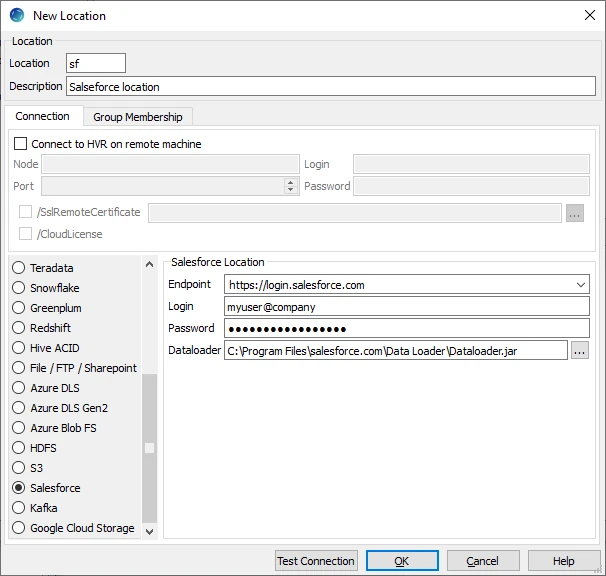
Replicating from Oracle to Salesforce
This section demonstrates how to replicate tables from an Oracle database on a source location to a Salesforce database on a target location.
Create Channel - Oracle to Salesforce
To create a channel (ora2sf) in HVR:
- In the navigation tree pane, right-click Channel Definitions ▶ New Channel.
- Enter the name and optionally the description for the channel in the New Channel dialog.
- Click OK.
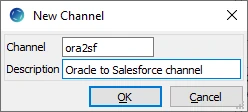
Create Location Groups
This section describes how to create location groups in the channel. Location groups are used for defining actions on the location. Typically, a channel contains two location groups - one for the source location and one for the target location. Each location group can contain multiple locations.
In this example, create one source location group (e.g. SRCGRP) and one target location group (e.g. TGTGRP).
In the navigation tree pane, click + next to the channel (ora2sf).
Create the source location group (SRCGRP):
- Right-click Location Groups ▶ New Group.
- Enter the group name and optionally the description for the location group.
- Select the source location (ora1) in Group Membership.
- Click OK.
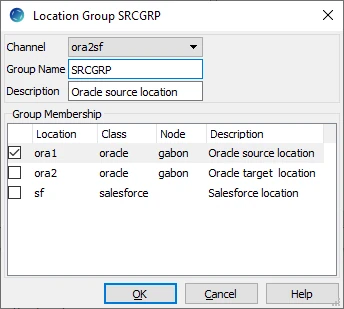
Create the target location group (TGTGRP):
- Right-click Location Groups ▶ New Group.
- Enter the group name and optionally the description for the location group.
- Select the target location (sf) from Group Membership.
- Click OK.
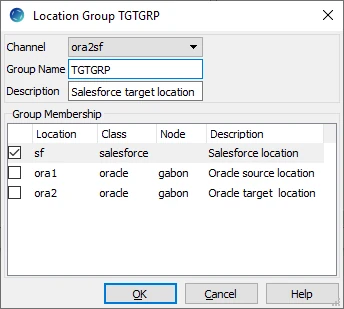
Select Table(s)
This section describes how to select the table (dm51_product) from the source location for replication. Table Explore allows you to select schema(s) and/or table(s) for replication.
Right-click Tables ▶ Table Explore.
Select the source location (ora1) from the list.
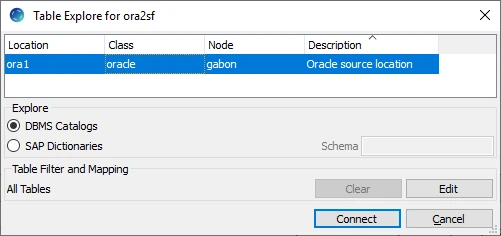
Click Connect.
Select table dm51_product in the Table Explore dialog. Press the Shift key if you need to select multiple tables or Ctrl+A to select all tables.
Click Add to add the selected table.
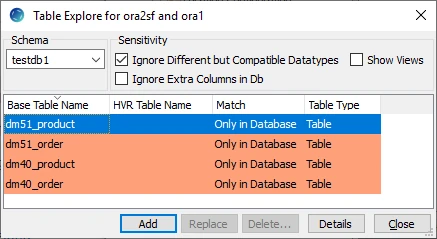
Click OK in the HVR Table Name dialog.
Click Close in the Table Explore dialog.
Double-click table dm51_product and make column prod_id a key column by selecting the Key checkbox.
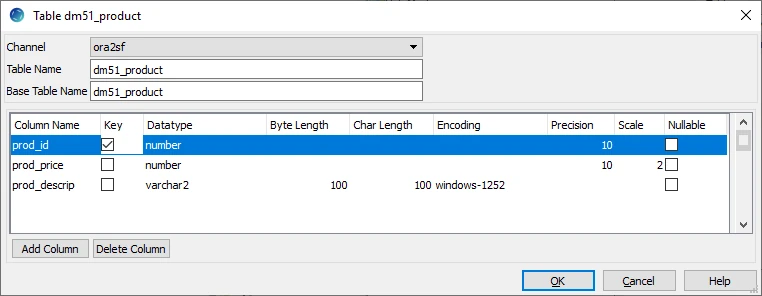
Define Actions
This section describes how to define actions on the location groups (SRCGRP and TGTGRP). Actions define the behavior of the replication activity. The new channel needs two actions to indicate the direction of replication, and actions to map the database table and column names in Oracle to Salesforce objects and Field API names.
Define action Capture with parameter /LogReadMethod=DIRECT to capture changes from the table in the source location group (SRCGRP).
In the navigation tree pane, right-click source location group SRCGRP ▶ New Action ▶ Capture.
Click OK.
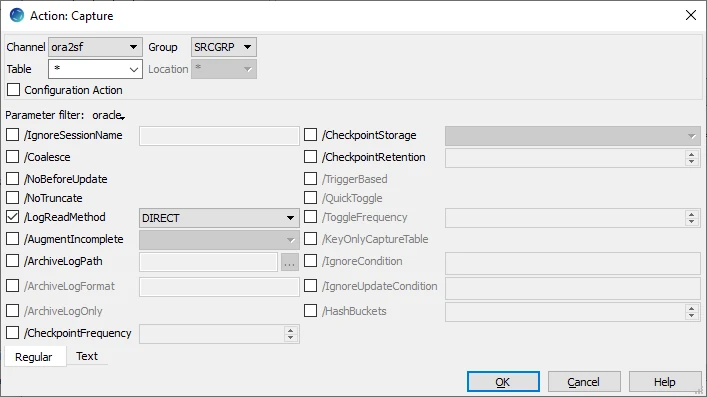
Define action Integrate to integrate changes to the table object in the target location group (TGTGRP).
In the navigation tree pane, right-click target location group TGTGRP ▶ New Action ▶ Integrate.
Click OK.
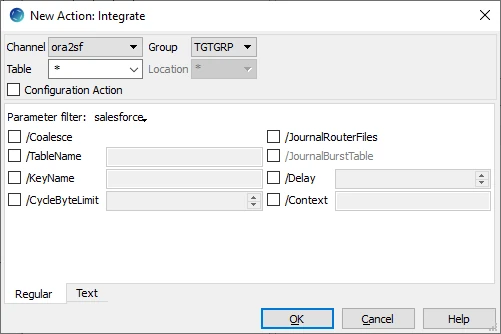
Action Integrate only integrates insert and update statements, not deletes.
Define actions TableProperties and ColumnProperties to map the source table and columns in Oracle to the relevant target table objects and fields in Salesforce.
In the navigation tree pane, right-click group TGTGRP ▶ New Action ▶ TableProperties. In the TableProperties dialog, choose table dm51_product, then select /BaseName and enter the Salesforce API Name dm51_product__c.
Right-click group TGTGRP ▶ New Action ▶ ColumnProperties. In the ColumnProperties dialog, choose table dm51_product, then select /Name, click the browse button and select column prod_id. Select /BaseName and enter the Salesforce API Name.
Right-click group TGTGRP ▶ New Action ▶ ColumnProperties. In the ColumnProperties dialog, choose table dm51_product, then select /Name, click the browse button and select column prod_price. Select /BaseName and enter the Salesforce API Name prod_price__c.
Right-click group TGTGRP ▶ New Action ▶ ColumnProperties. In the ColumnProperties dialog, choose table dm51_product, then select /Name, click the browse. button and select column prod_descrip. Select /BaseName and enter the Salesforce API Name prod_descrip__c.
Salesforce API names are case-sensitive.
Channel Group Table Location Action ora2sf TGTGRP dm51_product * TableProperties /BaseName=dm51_product__c ora2sf TGTGRP dm51_product * ColumnProperties /Name=prod_id /BaseName=Name ora2sf TGTGRP dm51_product * ColumnProperties /Name=prod_price /BaseName=prod_price__c ora2sf TGTGRP dm51_product * ColumnProperties /Name=prod_descrip /BaseName=prod_descrip__c
In the navigation tree pane, click channel ora2sf to see all configuration actions defined for the channel.
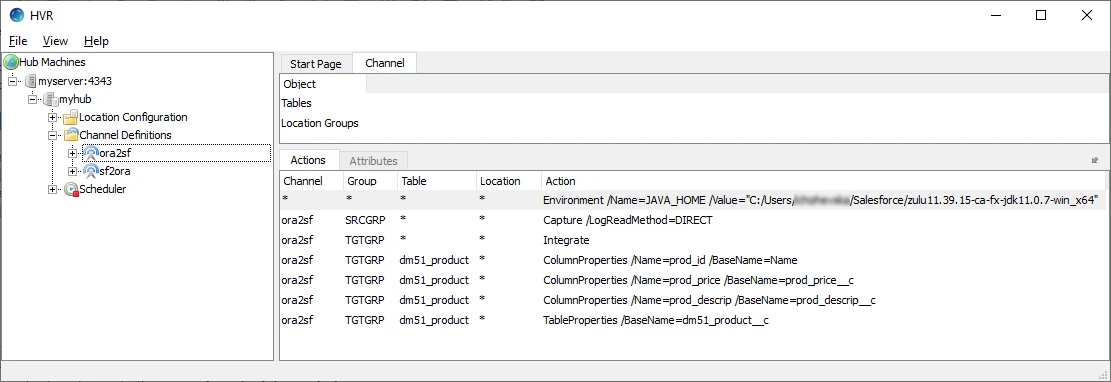
Initialize
This section describes how to initialize the replication. HVR Initialize first checks the channel and creates replication jobs in the HVR Scheduler.
- Right-click channel ora2sf ▶ HVR Initialize.
- Select Create or Replace Objects in the HVR Initialize dialog.
- Click Initialize.
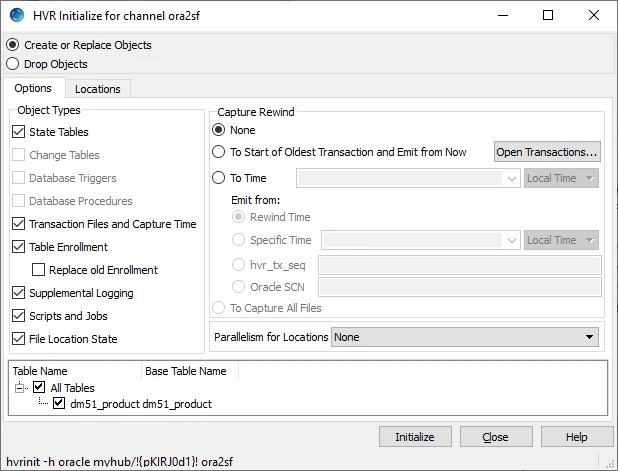
- Click OK.

- Click Close in the HVR Initialize for channel ora2sf dialog.
- Expand the Scheduler node in the navigation tree pane to view the capture and integrate jobs. For more information about initiating replication in HVR, see section Replication Overview.
Start Scheduler
This section describes how to start the HVR Scheduler. The HVR Scheduler is a process which runs jobs defined in the catalog table HVR_JOB. This catalog table can be found in the hub database. On Unix or Linux, the HVR Scheduler runs as a daemon. On Windows, the HVR Scheduler runs as a system service.
Start the Scheduler. In the navigation tree pane, right-click Scheduler ▶ Start.
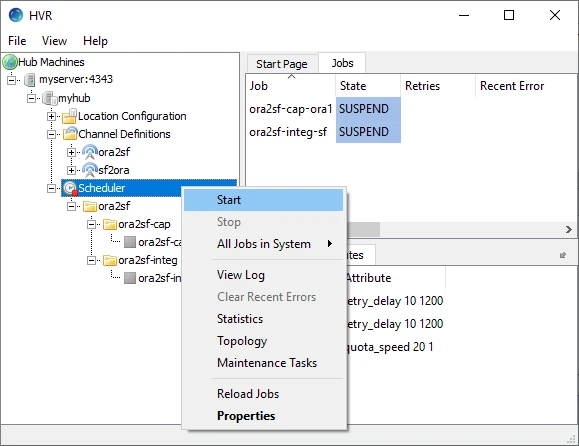
On Windows, the following steps are required to create the HVR Scheduler system service.
- Click Create in the prompt asking to create the service hvrscheduler_myhub.
- Select Local System Account ('SYSTEM') in the Create Windows Service dialog.
- Click Create.

Start Capture Job
This section describes how to start the job for capturing changes from the source location (ora1). By starting the Capture job in HVR Scheduler, HVR begins capturing all changes since the moment HVR Initialize was executed. This 'capture begin moment' can be modified using the option Capture Rewind available in the Advanced Options tab of the HVR Initialize dialog.
In the navigation tree pane, click Scheduler.
Start the capture job. In the Jobs pane, right-click capture job ora2sf-cap-ora1 ▶ Start.
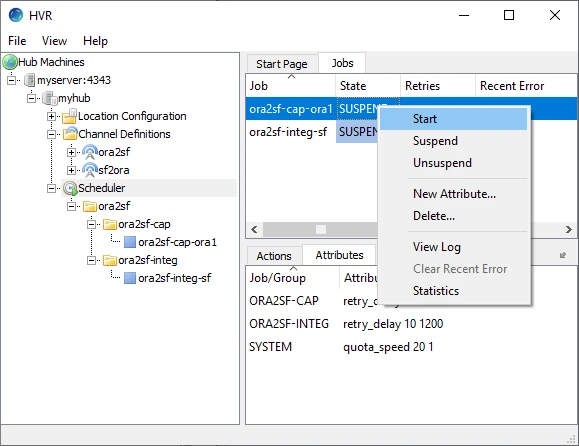
Click Yes in the Start dialog. On starting the capture job (ora2sf-cap-ora1) successfully, the status of the job changes from SUSPEND to RUNNING.
Start Integrate Job
This section describes how to start the job to integrate changes into the target location (sf).
In the navigation tree pane, click Scheduler.
Start the integrate job. In the Jobs pane, right-click integrate job ora2sf-integ-sf ▶ Start.
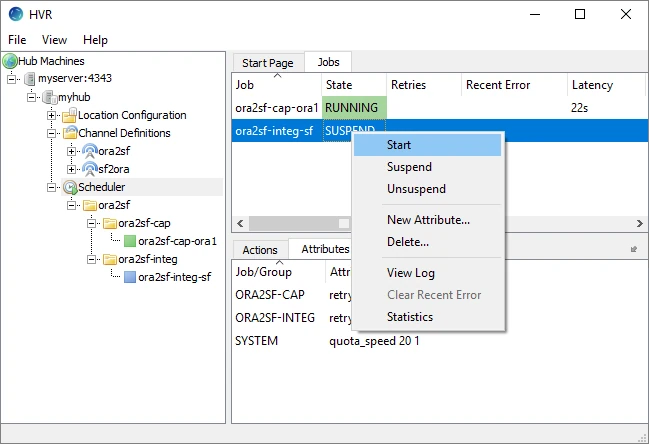
Click Yes in the Start dialog. On starting the integrate job (ora2sf-integ-sf) successfully, the status of the job changes from SUSPEND to RUNNING.
Verify Replication
Replication can be verified by inspecting the channel log file. HVR creates separate log files for the hub, channel (ora2sf), and for each replication jobs (ora2sf-cap-ora1 and ora2sf-integ-sf). These log files contain the details of the changes captured and integrated.
To view the replication activity log:
In the navigation tree pane, click + next to the Scheduler.
Right-click ora2sf ▶ View Log to view the log of both capture and integrate jobs.
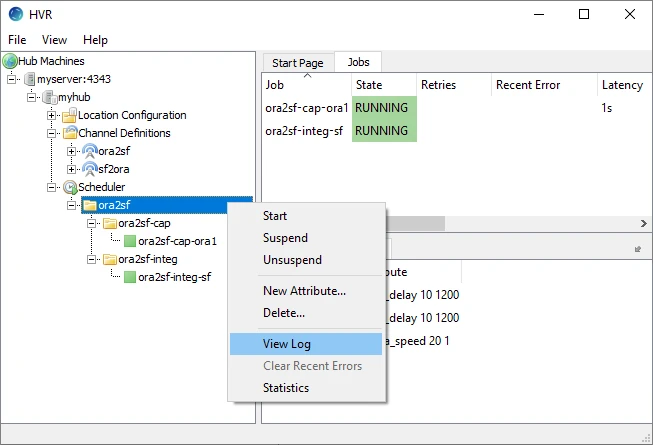
The logs for both capture and integrate jobs are displayed in the logs pane (Log of channel ora2sf) at the bottom of the screen.

The directory path for the HVR log files is displayed in the log tab.
Right-clicking a particular job and selecting View Log displays logs related to that job alone.
Insert, update, or delete value(s) in the source location database. For example:
insert into testdb1.dm51_product values (101, 91, 'Pencil');The output log is updated and indicates that the change is captured from the source location and integrated into the target location:

This indicates that the jobs replicated the original change to Salesforce. You can also verify the replication by looking at the Object data in Salesforce.
Replicating from Salesforce to Oracle
This section demonstrates how to replicate tables from a Salesforce database on the source location to an Oracle database on the target location.
Create Channel - Salesforce to Oracle
To retrieve data from Salesforce, create a second channel sf2ora. Follow the steps above to create the channel and two location groups SRCGRP and TGTGRP; source group SRCGRP includes location sf, and target group TGTGRP includes location ora2.
Add Table(s)
For the Salesforce source location, you need to add tables manually.
- In the navigation tree pane, right-click Tables and click New Table.
- Enter the name of the table in the Oracle location in the Table Name field.
- Enter the name of the table in the Salesforce location in the Base Table Name field.
- Click Add Column to add columns to the table. The columns should correspond to the columns in Salesforce (Name, prod_price__c, prod_descrip__c).
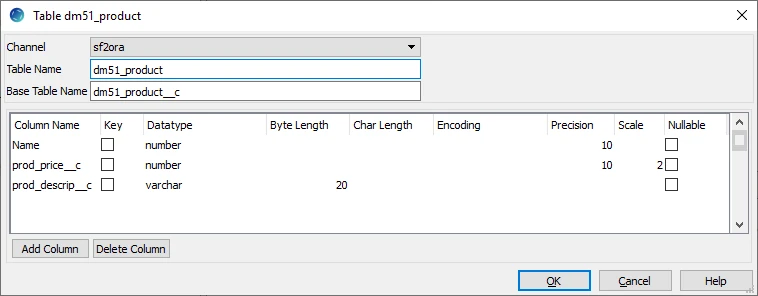
Define Actions
This section describes how to define actions on the location groups (SRCGRP and TGTGRP). Actions define the behavior of the replication activity. The new channel needs two actions to indicate the direction of replication, and actions to map database table and column names in Oracle to Salesforce objects and Field API names.
Define action Capture to capture changes from the tables in the source location group (SRCGRP).
In the navigation tree pane, right-click source location group SRCGRP ▶ New Action ▶ Capture.
Click OK.
Define action LocationProperties with parameter /BulkAPI to the source group SRCGRP to use Salesforce Bulk API (instead of the SOAP interface).
In the navigation tree pane, right-click source location group SRCGRP ▶ New Action ▶ LocationProperties.
Select /BulkAPI.
Click OK.
Channel Group Table Location Action sf2ora SRCGRP dm51_product * Capture sf2ora SRCGRP dm51_product * LocationProperties /BulkAPI
Define action **Integrate **to integrate changes to the table objects in the target location group (TGTGRP). Select /OnErrorSaveFailed and /Resilient=SILENT, this affects how replication errors are handled.
In the navigation tree pane, right-click target location group TGTGRP ▶ New Action ▶ Integrate.
Select /OnErrorSaveFailed.
Select /Resilient and pick SILENT from the drop-down menu.
Click OK.
Define action TableProperties and ColumnProperties to map the source object and fields in Salesforce to the relevant target table and columns in Oracle.
In the navigation tree pane, right-click group TGTGRP ▶ New Action ▶ TableProperties. In the TableProperties dialog, choose table dm51_product, then select /Schema and enter the schema name for the Oracle table.
Right-click group TGTGRP ▶ New Action ▶ ColumnProperties. In the ColumnProperties dialog, choose table dm51_product, then select /Name, click the browse button and select column prod_id. Select /BaseName and enter the Salesforce API Name Name.
Right-click group TGTGRP ▶ New Action ▶ ColumnProperties. In the ColumnProperties dialog, choose table dm51_product, then select /Name, click the browse button and select column prod_price. Select /BaseName and enter the Salesforce API Name prod_price__c.
Right-click group TGTGRP ▶ New Action ▶ ColumnProperties. In the ColumnProperties dialog, choose table dm51_product, then select /Name, click the browse button and select column prod_descrip. Select /BaseName and enter the Salesforce API Name prod_descrip__c.
Salesforce API names are case-sensitive.
Channel Group Table Location Action sf2ora TGTGRP dm51_product * Integrate /Resilient=SILENT /OnErrorSaveFailed sf2ora TGTGRP dm51_product * TableProperties /BaseName=dm51_product /Schema=testdb2 sf2ora TGTGRP dm51_product * ColumnProperties /Name=prod_id /BaseName=Name sf2ora TGTGRP dm51_product * ColumnProperties /Name=prod_price /BaseName=prod_price__c sf2ora TGTGRP dm51_product * ColumnProperties /Name=prod_descrip /BaseName=prod_descrip__c
In the navigation tree pane, click channel sf2ora to see all configuration actions defined for the channel.
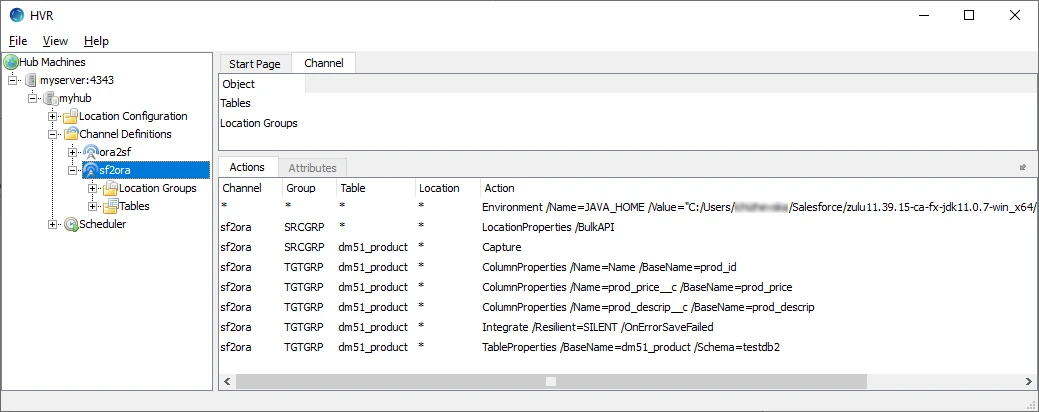
Initialize
This section describes how to initialize the replication. HVR Initialize first checks the channel and creates replication jobs in the HVR Scheduler.
- Right-click channel sf2ora ▶ HVR Initialize.
- Select Create or Replace Objects in HVR Initialize dialog.
- Click Initialize.
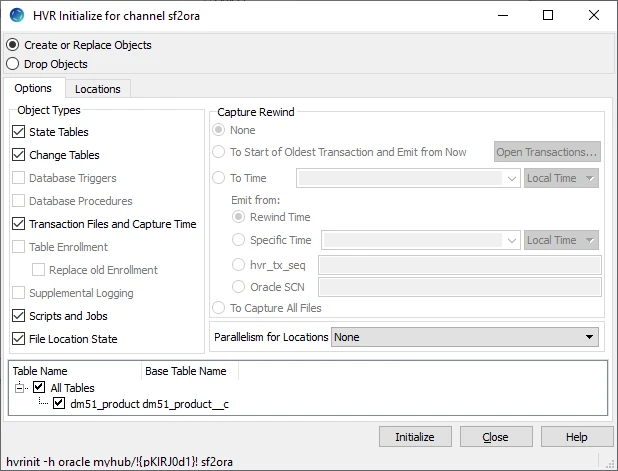
- Click OK.

- Click Close in the HVR Initialize for channel sf2ora dialog.
- Expand the Scheduler node in the navigation tree pane to view the capture and integrate jobs. For more information about initiating replication in HVR, see section Replication Overview.
- Right-click Scheduler and select Start.
Start Capture Job
This section describes how to start the job for capturing changes from the source location (sf). By starting the Capture job under the HVR Scheduler, HVR begins capturing all changes since the moment HVR Initialize was executed. This 'capture begin moment' can be modified using the option Capture Rewind available in the Advanced Options tab of the HVR Initialize dialog.
In the navigation tree pane, click Scheduler.
Start the capture job: in the Jobs pane, right-click capture job sf2ora-cap-sf ▶ Start.
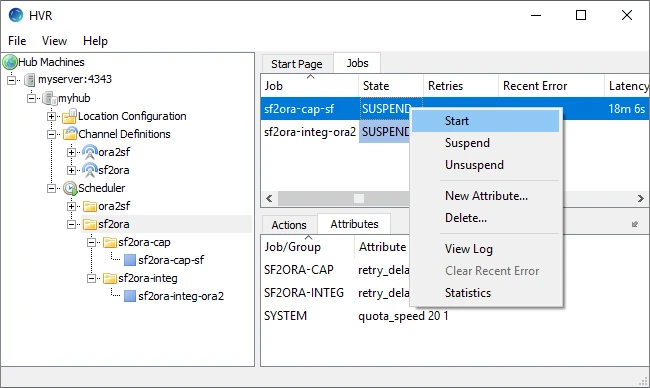
Click Yes in the Start dialog. On starting the capture job (sf2ora-cap-sf) successfully, the status of the job changes from SUSPEND to RUNNING.
Start Integrate Job
This section describes how to start the job to integrate changes into the target location (ora2).
In the navigation tree pane, click Scheduler.
Start the integrate job. In the Jobs pane, right-click integrate job sf2ora-integ-ora2 ▶ Start.
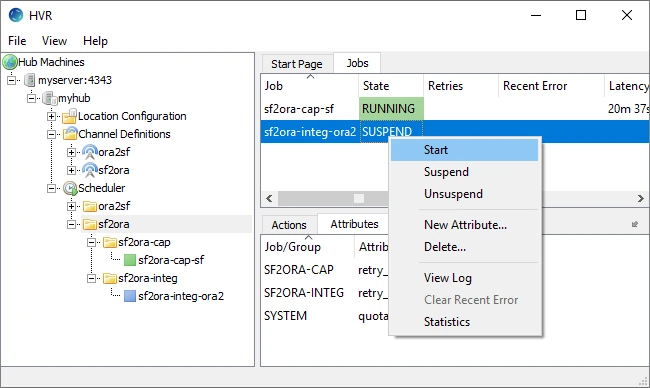
Click Yes in the Start dialog. On starting the integrate job (sf2ora-integ-ora2) successfully, the status of the job changes from SUSPEND to RUNNING.
Verify Replication
Replication can be verified by inspecting the channel log file. HVR creates separate log files for the hub, channel (sf2ora), and for each replication jobs (sf2ora-cap-fs and sf2ora-integ-ora2). These log files contain the details of the changes captured and integrated.
To view the replication activity log:
In the navigation tree pane, click + next to the Scheduler.
Right-click sf2ora ▶ View Log to view the log of both capture and integrate jobs.
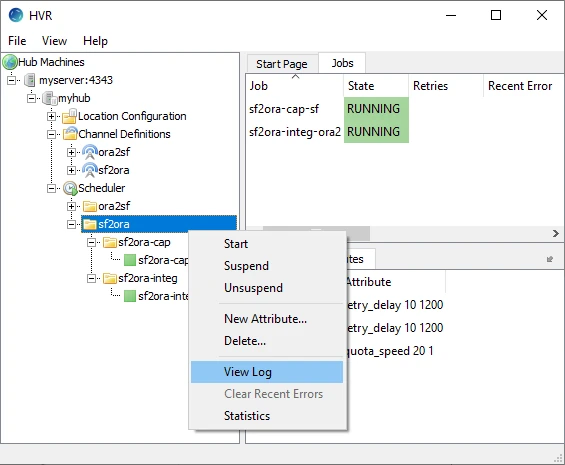
The logs for both capture and integrate jobs are displayed in the logs pane (Log of channel sf2ora) at the bottom of the screen.
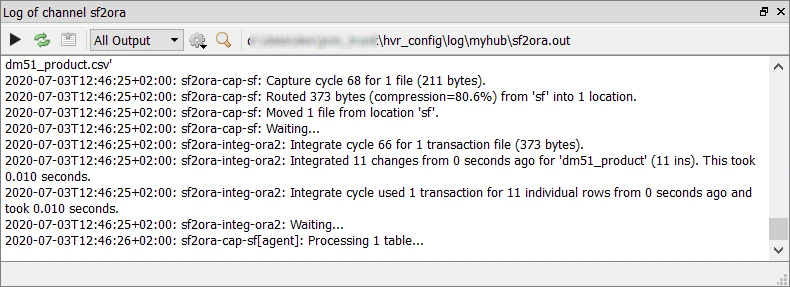
The directory path for the HVR log files is displayed in the log tab.
Right-clicking a particular job and selecting View Log displays logs related to that job alone.
Insert data into the Salesforce table and save.
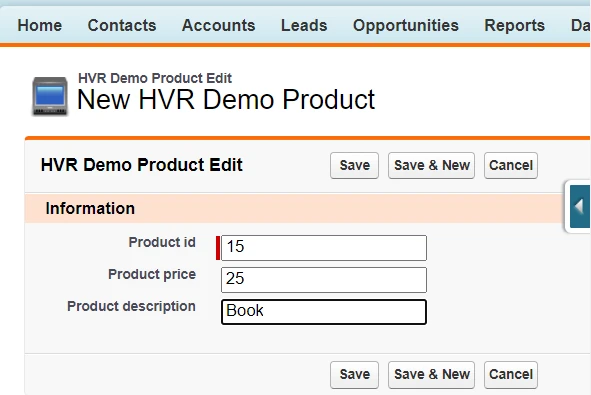
The output log is updated and indicates that the change is captured from the source location and integrated into the target location:
